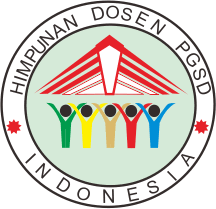Analisis kesalahan siswa dalam memecahkan masalah soal cerita matematika materi skala ditinjau dari kecerdasan linguistik di sekolah dasar
Abstract
Abstract. This research aims to describe the types and causes of errors students in solving math story problems on a fifth grade scale material in terms of linguistic intelligence uses a qualitative descriptive method with a case study. This research uses test and interview data collection techniques. Based on the results of the research, it can be concluded that the type of error students with high linguistic intelligence are errors in carry out the plans and errors in look back the answers because of inaccuracy in calculating math operations. Type the error of students with moderate linguistic intelligence is a mistaken devise a plan, carry out the plan, and look back the answers couse of the lack of ability in mathematical arithmetic operations and inaccuracy in writing the answer. The types of errors of students with linguistic intelligence low is an error in understanding the problem mistaken devise a plan, carry out the plan, and look back the answers because of the lack of ability read, Lack of ability in mathematical arithmetic operations, and look back the answers.
Keywords
Full Text:
PDFReferences
Ardiyanti, Haninda, B., & Tina, Y. (2014). Analisis Kesalahan Dalam Mengerjakan Soal Cerita Matematika. Jurnal Pendidikan Matematika Unila, 2-7. [2] Ashlock. (2003). Guiding Each Child's Learning of Mathematics. Colombus: Bell Company. [3] Budhayanti. (2008). Pemecahan Masalah Matematika. Jakarta: Rajawali Perss. [4] Depdiknas. (2003). Undang-undang RI No.20 tahun 2003 tentang Sistem pendidikan Nasional. Retrieved from https://pmpk.kemdikbud.go.id/assets/docs/UU_2003_No_20_-_Sistem_Pendidikan_Nasional.pdf [5] Hamzah, A. (2014). Perencanaan dan Strategi Pembelajaran Matematika. Jakarta: Rajawali Press. [6] Herumen. (2007). Model Pembelajaran Matematika di Sekolah Dasar. Bandung: Remaja Rosdakarya. [7] Jasmine, J. (2007). Panduan Praktis Mengajar Berbasis Multiple Intelligences. Bandung: Nuansa. [8] Jha, S. K. (2012). Mathematics Performance of Primary School Students In Assam (India): An Analysis Using Newman Prosedure. International Journal of Computer Applications in Engineering Sciences , 17-21. [9] Marlina. (2013). Penerapan Langkah Polya dalam Menyelesaikan Soal Cerita Keliling dan Luas Persegi Panjang. Jurnal Elektronok Pendidikan Matematika Tadulako , 43-52. [10] Moleong, L. J. (2004). Metodologi Penelitian Kualitatif. Bandung: Remaja Rosdakarya. [11] Patilima, H. (2007). Metode Penelitian Kualitatif. Jakarta: Alfabeta. [12] Pitadjeng. (2006). Pembelajaran Matematika yang Menyenangkan. Jakarta: Depdiknas. [13] Polya, G. (1973). How To Solve It: A New Aspect of Mathematical Method. New Jersey: Pricenton University Press. [14] Sugiyono. (2007). metode Penelitian Kuantitatif Kualitatif dan R & D. Bandung: Alfabeta. [15] Ulliya, F., Rohman, A. A., & Cahyono, B. (2018). Pengaruh Kecerdasan Linguistik Terhadap Kemampuan Koneksi Matematis dalam Menyelesaikan Masalah Open Ended Materi Trigonometri. Jurnal Pendidikan MIPA, 101-113.
Refbacks
- There are currently no refbacks.



